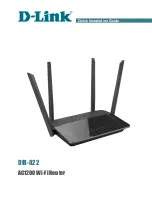
81
●
POP
— Post Office Protocol. An Internet protocol for retrieving email from a remote server over a TCP/
IP connection.
●
Port
— A virtual data connection used by programs to exchange data. It is the endpoint in a logical
connection. The port is specified by the port number.
●
Port Forwarding
— A process that allows remote devices to connect to a specific computer within a
private LAN.
●
Port Number
— A 16-bit number used by the TCP and UDP protocols to direct traffic on a TCP/IP
host. Certain port numbers are standard for common applications.
●
Protocol
— A standard that enables connection, communication, and data transfer between
computing endpoints.
●
PPP
— Point-to-Point Protocol. A method of connecting a computer to the Internet.
●
PPTP
— Point-to-Point Tunneling Protocol. A method for implementing virtual private networks that
does not provide confidentiality or encryption but relies on the tunneling process for security.
●
PRL
— Preferred Roaming List. A list that your wireless phone or device uses to determine which
networks to connect with when you are roaming. (Network operator specific)
●
Protocol
— A standard that enables connection, communication, and data transfer between
computing endpoints.
●
Proxy
— A firewall mechanism that replaces the IP address of a host on the internal (protected)
network with its own IP address for all traffic passing through it.
●
PUK code
(Pin Unlock Key) — A PUK is required when you enter an incorrect PIN 3 times. After
entering the wrong PIN 3 times, the SIM card is disabled.
●
RAS
— Remote Access Service. A Windows NT/2000 Server feature that allows remote users access to
the network from their Windows laptops or desktops via modem.
●
Rev A
— CDMA EV-DO Rev. A is a leading-edge wireless technology with higher data rates and higher
system capacity. It is a fully backward compatible standard and remains interoperable with deployed
EV-DO networks and devices around the world. The increased data rates on Rev. A’s physical layer
enable richer applications and services. For more information, visit
www.cdg.org
.
●
RFB
— Remote Frame Buffer. A protocol for remote access to graphical user interfaces.
●
Router
— A device that directs traffic from one network to another.
●
RTP
— Real-time Transport Protocol. A packet format for streaming multimedia over the Internet.
●
SIM
— Subscriber Identification Module. Found in GSM network technology, the SIM is a card
containing identification information for the subscriber and their account. The SIM card can be moved
to different devices.
●
SMS
— Short Message Service. A service for sending short messages of up to 160 (224 in 5-bit mode)
characters to mobile devices. SMS is also known as text messaging.
●
SMTP
— Simple Mail Transfer Protocol. An Internet standard for email transmission across IP networks.
●
SSID
— Service Set IDentifier. The name assigned to a Wi-Fi network.
Содержание Sprint mifi 4082
Страница 18: ...15 The MiFi Landing Page opens ...
Страница 23: ...Using microSDHC Cards with MiFi File Sharing Using MiFi and Sharing Files 2 ...
Страница 34: ...31 File Sharing See Using microSDHC Cards with MiFi page 23 for more information about File Sharing ...
Страница 66: ...Overview Common Problems and Solutions Using the Master Reset Button Troubleshooting 4 ...
Страница 80: ...Glossary 6 ...



































